高中英语人教版必修五Unit 5 First aid-Grammar课件(30张)
文档属性
| 名称 | 高中英语人教版必修五Unit 5 First aid-Grammar课件(30张) | 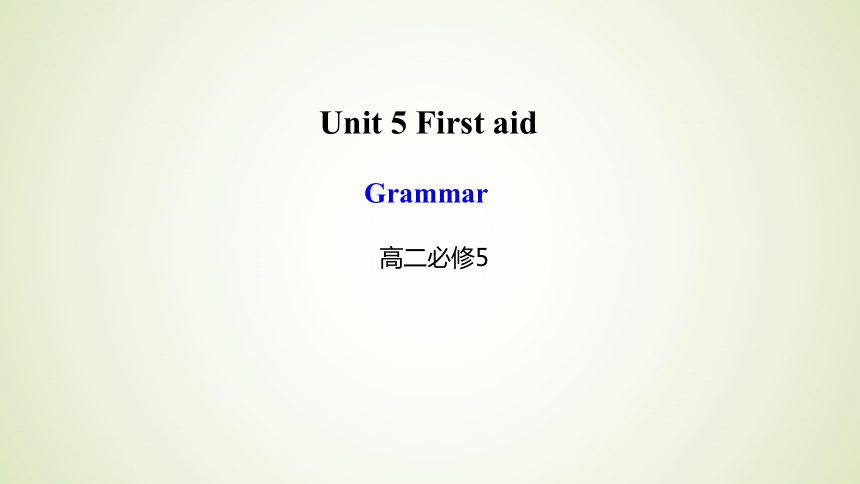 | |
| 格式 | zip | ||
| 文件大小 | 836.4KB | ||
| 资源类型 | 教案 | ||
| 版本资源 | 人教版(新课程标准) | ||
| 科目 | 英语 | ||
| 更新时间 | 2019-03-11 20:07:59 | ||
图片预览



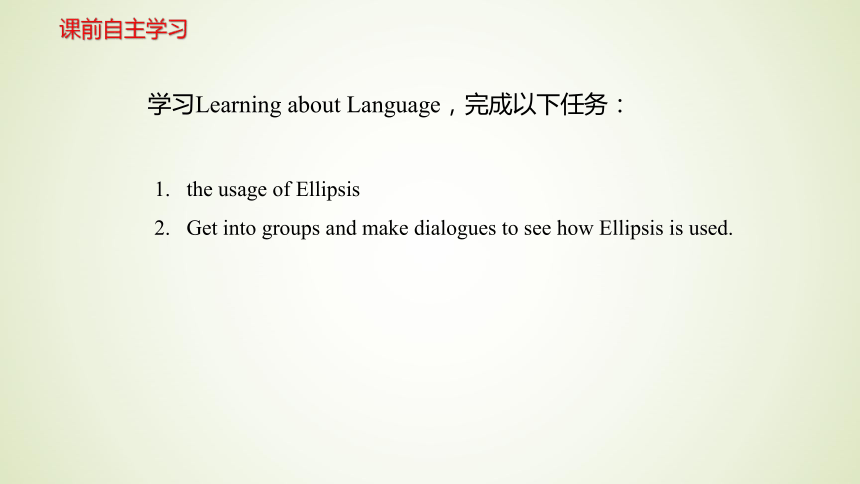

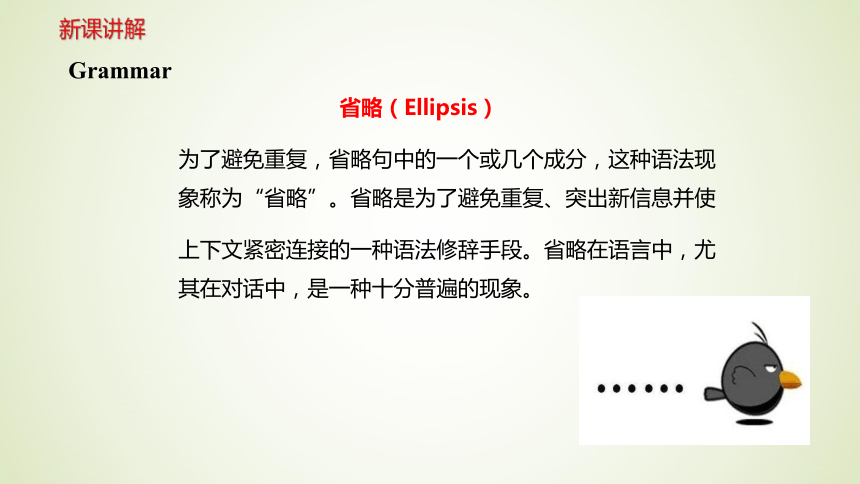
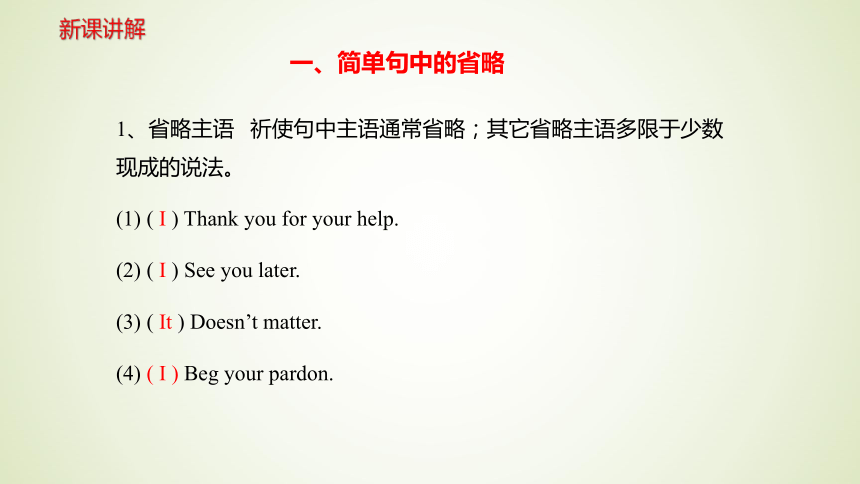
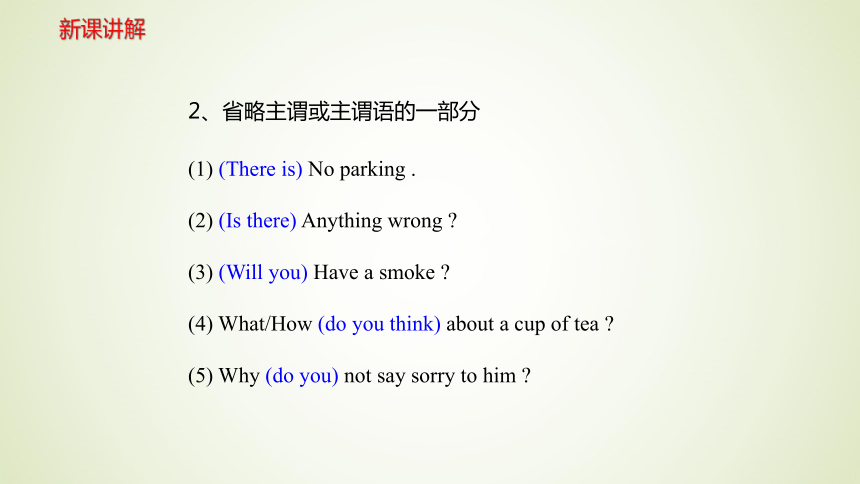
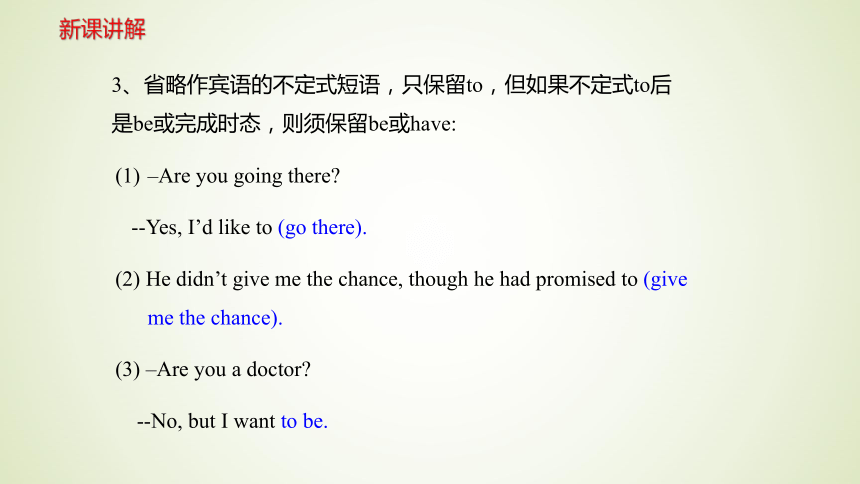

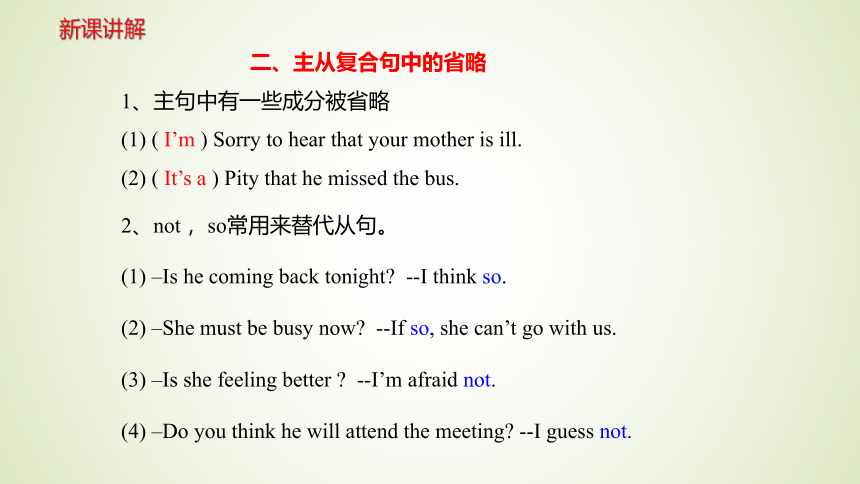
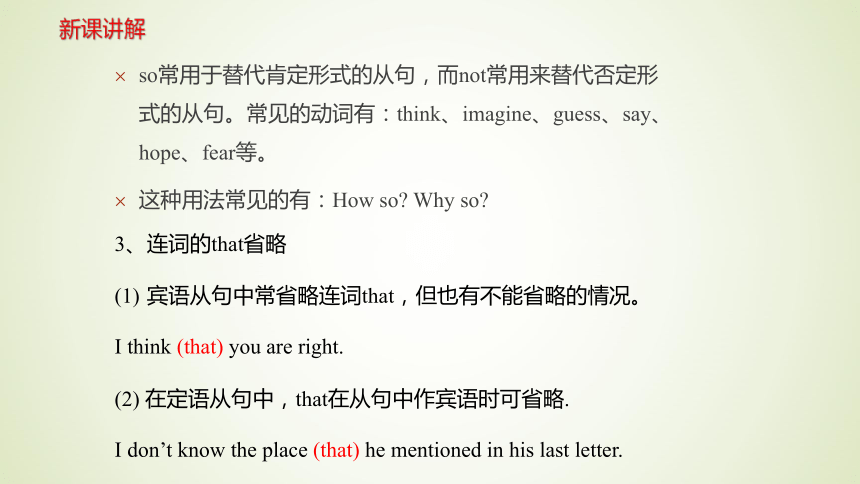
文档简介
课件30张PPT。高二必修5Unit 5 First aid
Grammar
情景导入1. To learn how to use Ellipsis.?
2. To know the reasons why we use Ellipsis and its different usage in different situations.
3. To develop ability to use Ellipsis.?学习目标课前自主学习学习Learning about Language,完成以下任务:the usage of Ellipsis
Get into groups and make dialogues to see how Ellipsis is used.
2019/3/115自主学习反馈Often the illness or injury is not serious, but there are other times when (the illness or injury is serious and ) giving first aid quickly can save lives.
Burns are called first (degree burns), second (degree burns) or third degree burns …
These affect both the top (layer of the skin) and the second layer of the skin. 省略(Ellipsis)
为了避免重复,省略句中的一个或几个成分,这种语法现象称为“省略”。省略是为了避免重复、突出新信息并使
上下文紧密连接的一种语法修辞手段。省略在语言中,尤其在对话中,是一种十分普遍的现象。
新课讲解Grammar一、简单句中的省略1、省略主语 祈使句中主语通常省略;其它省略主语多限于少数现成的说法。
(1) ( I ) Thank you for your help.
(2) ( I ) See you later.
(3) ( It ) Doesn’t matter.
(4) ( I ) Beg your pardon.
新课讲解2、省略主谓或主谓语的一部分 (1) (There is) No parking .
(2) (Is there) Anything wrong ?
(3) (Will you) Have a smoke ?
(4) What/How (do you think) about a cup of tea ?
(5) Why (do you) not say sorry to him ?新课讲解3、省略作宾语的不定式短语,只保留to,但如果不定式to后是be或完成时态,则须保留be或have:–Are you going there?
--Yes, I’d like to (go there).
(2) He didn’t give me the chance, though he had promised to (give me the chance).
(3) –Are you a doctor?
--No, but I want to be.新课讲解4、省略表语
(1) –Are you thirsty? --Yes, I am (thirsty).
(2) His brother isn’t lazy, nor is his sister (lazy).
5、同时省略几个成分
(1) Let’s meet at the same place as (we met) yesterday.
(2) –-Have you finished your work ?
---(I have) Not (finished my work) yet.
新课讲解 二、主从复合句中的省略
1、主句中有一些成分被省略
(1) ( I’m ) Sorry to hear that your mother is ill.
(2) ( It’s a ) Pity that he missed the bus.2、not, so常用来替代从句。
(1) –Is he coming back tonight? --I think so.
(2) –She must be busy now? --If so, she can’t go with us.
(3) –Is she feeling better ? --I’m afraid not.
(4) –Do you think he will attend the meeting? --I guess not.
新课讲解so常用于替代肯定形式的从句,而not常用来替代否定形式的从句。常见的动词有:think、imagine、guess、say、hope、fear等。
这种用法常见的有:How so? Why so? 3、连词的that省略
宾语从句中常省略连词that,但也有不能省略的情况。
I think (that) you are right.
(2) 在定语从句中,that在从句中作宾语时可省略.
I don’t know the place (that) he mentioned in his last letter.新课讲解4、在某些状语从句中,从句的主语与主句的主语一致时,可省去“主语+be”部分 When (he was) still a boy of 10, he had to work day and night.
She tried her best though (she was) rather poor in health.
If (you are) asked you may come in.
If (it is) necessary I’ll explain to you again.新课讲解三、并列句中的省略 两个并列句中,后一个分句常省略与前一分句中相同的部分。
(1) My father is a doctor and my mother (is) a nurse.
(2) I study at college and my sister (studies) at high school.
(3) When summer comes, the day is getting longer and longer, and the night (is getting) shorter and shorter.
新课讲解 其他省略1、不定式符号to的省略
并列的不定式可省去后面的 to.
I told him to sit down and wait for a moment.
(2) help 当“帮助”讲时,后面的宾语或宾补的不定式符号to可带可不带.
I will help (to) do it for you.
(3) 介词but前若有动词do,后面的不定式不带 to.
The boy did nothing but cry.新课讲解(4) 某些使役动词(let, make, have)及感官动词(see, watch, hear, notice, observe, feel, look at, listen to等)后面作宾语补足语的不定式一定要省去 to, 但在被动语态中须将to 复原。
I saw the boy fall off the tree.
The boy was seen to fall off the tree.
The boss made us work 12 hours a day.
We were made to work 12 hours a day.新课讲解(5) 主语从句中有动词do,后面作表语的不定式的 to可带可不带。
All we can do now is (to) wait.
What we can do now is (to) wait.
(6) find 当“发现”讲时,后面作宾语补足语的不定式符号to可带可不带。
We found him (to) work very hard at the experiment.
但如果是不定式 to be,则不能省略。
She found him to be dishonest. 新课讲解2、连词if在部分虚拟条件句中可省略,但后面的语序有变化。
(1) Had they time, they would certainly come and help us.
(2) Were I you, I would do the work better.
(3)Should there be a flood, what should we do?
3、主句和从句各有一些成分省略。The sooner (you do it), the better (it will be).
(Where there is ) No pain , (there is ) no gain. 新课讲解In groups, look at these pairs of sentences. Discuss the difference between A and B in each pair. Also discuss which is the better sentence and why.2新课讲解 The difference between sentence A and B:
1.) There are lots of repeated words and phrases in sentence A.
2.) Sentence B is better than Sentence A because it doesn’t have unnecessary repetition in it, and it is easier to understand and it sounds much less awkward than sentence A.Practice3Rewrite these sentences by taking out the unnecessary parts.The burn (that )she got from the iron was red and( it was) very painful.
A boy was on the left side of the sick woman, and a girl was on the right (side of the sick woman).新课讲解3. She has a daughter (who is) in hospital.
4. He went to the doctor because he had to (go to the doctor) .
5. Did she pass the first aid test that she did yesterday or didn’t she pass?not6. She could not decided whether to send him to hospital or not
(to send him to hospital).新课讲解7. When your nose is bleeding, (you should ) bend forward so that the blood runs out of your nose and the blood doesn’t run down your throat.
8. Only some of the students have done a first aid course but most (of the students) haven’t (done a first aid course). not新课讲解 These sentences are correct. However, one or more words have been left out. Can you tell your partner which words are missing ?41. The temple (which is) surrounded by a wall belongs to the local government.新课讲解 3. To her teacher’s surprise, she did better in her first aid exam than (she was) expected (to do).在than, as引导的比较状语从句中的省略2. The first book (that) I read this term was more interesting than the second.
(book that I read this term).定语从句中的省略新课讲解 5. He wanted to help the accident victim but his friend didn’t (want to help the accident victim).在并列中,后面分句中与前面分句中相同的部分常可省略4. I don’t think they have returned
from the hospital, but they might have (returned from the hospital).在并列中,后面分句中与前面分句中相同的部分常可省略新课讲解 6. You can borrow my first aid notes if you want to (borrow my first aid notes).
7. (It) sounds like a good idea.
8. (Is there) anything I can do for you?
不定式后省略动词
新课讲解小组讨论DiscussionDiscuss the usage of Ellipsis and in pairs make sentences using Ellipsis. Check them in class.随堂检测请完成《 Unit 5 First aid-Grammar》随堂检测!
省略成分: 主谓宾, 定状表
省略原则: 省略重复的内容,省略后, 不致令人费解。
省略类型:
1. 心照不宣型 (用于祈使句和某些现成的简单句中);
2. 承前省后型 (用于对话、并列句和动词不定式中);
3. 可有可无型 ( 用于宾语从句中的that、定语从句中作
宾语的whom, which, that和某些状语从句中)
4. 虚拟倒装型 (只用于需要倒装的虚拟条件句中)。
课堂小结I. 1. 完成《 Unit 5 First aid-Grammar 》课后作业 。
2. 总结省略的用法。课后作业Preview the Using language part.1. Important words and phrases and the grammar check. 2. How much do you know about the Reading 2?
Grammar
情景导入1. To learn how to use Ellipsis.?
2. To know the reasons why we use Ellipsis and its different usage in different situations.
3. To develop ability to use Ellipsis.?学习目标课前自主学习学习Learning about Language,完成以下任务:the usage of Ellipsis
Get into groups and make dialogues to see how Ellipsis is used.
2019/3/115自主学习反馈Often the illness or injury is not serious, but there are other times when (the illness or injury is serious and ) giving first aid quickly can save lives.
Burns are called first (degree burns), second (degree burns) or third degree burns …
These affect both the top (layer of the skin) and the second layer of the skin. 省略(Ellipsis)
为了避免重复,省略句中的一个或几个成分,这种语法现象称为“省略”。省略是为了避免重复、突出新信息并使
上下文紧密连接的一种语法修辞手段。省略在语言中,尤其在对话中,是一种十分普遍的现象。
新课讲解Grammar一、简单句中的省略1、省略主语 祈使句中主语通常省略;其它省略主语多限于少数现成的说法。
(1) ( I ) Thank you for your help.
(2) ( I ) See you later.
(3) ( It ) Doesn’t matter.
(4) ( I ) Beg your pardon.
新课讲解2、省略主谓或主谓语的一部分 (1) (There is) No parking .
(2) (Is there) Anything wrong ?
(3) (Will you) Have a smoke ?
(4) What/How (do you think) about a cup of tea ?
(5) Why (do you) not say sorry to him ?新课讲解3、省略作宾语的不定式短语,只保留to,但如果不定式to后是be或完成时态,则须保留be或have:–Are you going there?
--Yes, I’d like to (go there).
(2) He didn’t give me the chance, though he had promised to (give me the chance).
(3) –Are you a doctor?
--No, but I want to be.新课讲解4、省略表语
(1) –Are you thirsty? --Yes, I am (thirsty).
(2) His brother isn’t lazy, nor is his sister (lazy).
5、同时省略几个成分
(1) Let’s meet at the same place as (we met) yesterday.
(2) –-Have you finished your work ?
---(I have) Not (finished my work) yet.
新课讲解 二、主从复合句中的省略
1、主句中有一些成分被省略
(1) ( I’m ) Sorry to hear that your mother is ill.
(2) ( It’s a ) Pity that he missed the bus.2、not, so常用来替代从句。
(1) –Is he coming back tonight? --I think so.
(2) –She must be busy now? --If so, she can’t go with us.
(3) –Is she feeling better ? --I’m afraid not.
(4) –Do you think he will attend the meeting? --I guess not.
新课讲解so常用于替代肯定形式的从句,而not常用来替代否定形式的从句。常见的动词有:think、imagine、guess、say、hope、fear等。
这种用法常见的有:How so? Why so? 3、连词的that省略
宾语从句中常省略连词that,但也有不能省略的情况。
I think (that) you are right.
(2) 在定语从句中,that在从句中作宾语时可省略.
I don’t know the place (that) he mentioned in his last letter.新课讲解4、在某些状语从句中,从句的主语与主句的主语一致时,可省去“主语+be”部分 When (he was) still a boy of 10, he had to work day and night.
She tried her best though (she was) rather poor in health.
If (you are) asked you may come in.
If (it is) necessary I’ll explain to you again.新课讲解三、并列句中的省略 两个并列句中,后一个分句常省略与前一分句中相同的部分。
(1) My father is a doctor and my mother (is) a nurse.
(2) I study at college and my sister (studies) at high school.
(3) When summer comes, the day is getting longer and longer, and the night (is getting) shorter and shorter.
新课讲解 其他省略1、不定式符号to的省略
并列的不定式可省去后面的 to.
I told him to sit down and wait for a moment.
(2) help 当“帮助”讲时,后面的宾语或宾补的不定式符号to可带可不带.
I will help (to) do it for you.
(3) 介词but前若有动词do,后面的不定式不带 to.
The boy did nothing but cry.新课讲解(4) 某些使役动词(let, make, have)及感官动词(see, watch, hear, notice, observe, feel, look at, listen to等)后面作宾语补足语的不定式一定要省去 to, 但在被动语态中须将to 复原。
I saw the boy fall off the tree.
The boy was seen to fall off the tree.
The boss made us work 12 hours a day.
We were made to work 12 hours a day.新课讲解(5) 主语从句中有动词do,后面作表语的不定式的 to可带可不带。
All we can do now is (to) wait.
What we can do now is (to) wait.
(6) find 当“发现”讲时,后面作宾语补足语的不定式符号to可带可不带。
We found him (to) work very hard at the experiment.
但如果是不定式 to be,则不能省略。
She found him to be dishonest. 新课讲解2、连词if在部分虚拟条件句中可省略,但后面的语序有变化。
(1) Had they time, they would certainly come and help us.
(2) Were I you, I would do the work better.
(3)Should there be a flood, what should we do?
3、主句和从句各有一些成分省略。The sooner (you do it), the better (it will be).
(Where there is ) No pain , (there is ) no gain. 新课讲解In groups, look at these pairs of sentences. Discuss the difference between A and B in each pair. Also discuss which is the better sentence and why.2新课讲解 The difference between sentence A and B:
1.) There are lots of repeated words and phrases in sentence A.
2.) Sentence B is better than Sentence A because it doesn’t have unnecessary repetition in it, and it is easier to understand and it sounds much less awkward than sentence A.Practice3Rewrite these sentences by taking out the unnecessary parts.The burn (that )she got from the iron was red and( it was) very painful.
A boy was on the left side of the sick woman, and a girl was on the right (side of the sick woman).新课讲解3. She has a daughter (who is) in hospital.
4. He went to the doctor because he had to (go to the doctor) .
5. Did she pass the first aid test that she did yesterday or didn’t she pass?not6. She could not decided whether to send him to hospital or not
(to send him to hospital).新课讲解7. When your nose is bleeding, (you should ) bend forward so that the blood runs out of your nose and the blood doesn’t run down your throat.
8. Only some of the students have done a first aid course but most (of the students) haven’t (done a first aid course). not新课讲解 These sentences are correct. However, one or more words have been left out. Can you tell your partner which words are missing ?41. The temple (which is) surrounded by a wall belongs to the local government.新课讲解 3. To her teacher’s surprise, she did better in her first aid exam than (she was) expected (to do).在than, as引导的比较状语从句中的省略2. The first book (that) I read this term was more interesting than the second.
(book that I read this term).定语从句中的省略新课讲解 5. He wanted to help the accident victim but his friend didn’t (want to help the accident victim).在并列中,后面分句中与前面分句中相同的部分常可省略4. I don’t think they have returned
from the hospital, but they might have (returned from the hospital).在并列中,后面分句中与前面分句中相同的部分常可省略新课讲解 6. You can borrow my first aid notes if you want to (borrow my first aid notes).
7. (It) sounds like a good idea.
8. (Is there) anything I can do for you?
不定式后省略动词
新课讲解小组讨论DiscussionDiscuss the usage of Ellipsis and in pairs make sentences using Ellipsis. Check them in class.随堂检测请完成《 Unit 5 First aid-Grammar》随堂检测!
省略成分: 主谓宾, 定状表
省略原则: 省略重复的内容,省略后, 不致令人费解。
省略类型:
1. 心照不宣型 (用于祈使句和某些现成的简单句中);
2. 承前省后型 (用于对话、并列句和动词不定式中);
3. 可有可无型 ( 用于宾语从句中的that、定语从句中作
宾语的whom, which, that和某些状语从句中)
4. 虚拟倒装型 (只用于需要倒装的虚拟条件句中)。
课堂小结I. 1. 完成《 Unit 5 First aid-Grammar 》课后作业 。
2. 总结省略的用法。课后作业Preview the Using language part.1. Important words and phrases and the grammar check. 2. How much do you know about the Reading 2?
